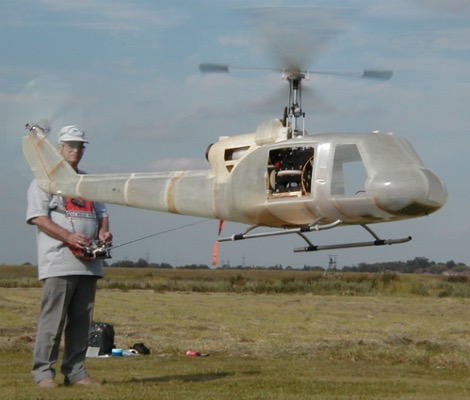
I still needed to generate an income so we looked around at what we could do next. At this time I was making my own scale competition fuselages but people would often ask me to make them one. It didn’t take me long to realise that after making the mould, I could turn out a high quality fuselage in two days and sell it for £400. This was so much easier and faster to do that making the equivalent amount from a set of rotor blades. It was also a lot more fun, so from the end of 1998, LM Blades became Len Mount Scale Fuselages so Olive and I were back in business.
I’ve always had an interest in scale models. In the early days I made scale aeroplanes from the World War 1 and World War 2 era, plus a couple of civilian planes. Then when I started building helicopters I went straight to building scale machines. Not content to just have a scale body I would start putting in seats and instrument panels. But as I got more into F3C aerobatic competitions and the need to continually practice, I dropped scale model building.
Between 1977 and 1997 I won 15 national F3C aerobatic championships including the UK, Scottish, Irish and New Zealand. Competition at this level wasn’t boring but it did get repetitious and it can easily take over your life. If you wanted to win you had to keep practicing and that meant being out in all weathers. But as I got older my reactions were getting slower so I had to practice even harder. Then one day I decided I had had enough and so I went back into scale modelling.
The contrast couldn’t be more different. Whereas with aerobatics I would have to go out every day of the week to practice, with scale flying I could get by with just a weekly flight as the manoeuvres are relatively easy. Then there were the machines. With F3C I would need three machines in top condition, but with scale I just needed one. And finally there was the cost. With F3C I would get through five engines in a year at an equivalent cost of £1000, while I would use six gallons of fuel each week in practicing at a cost of over £4,000. F3C was a rich mans sport! However in scale, one engine would be sufficient and the fuel used would be no more than that used by a typical ‘hobby’ flier.
The only other major difference was in the building. With aerobatics you can ‘buy’ a model that is capable of winning, but in scale, winning requires something special that money can’t buy. It requires an eye for detail, patience in making things in miniature, dedication and above all perseverance. Interestingly it needn’t be expensive. All the scale detail on my models are made from scrap or everyday objects that cost pennies. But it is hard work and does take time.
My return to scale modelling was serious. I put in ash-trays complete with cigarette butts, seat belts that would ‘click’ shut and seats work along with working adjustable height mechanisms. My cockpits would have gauges that consist of miniature photographs of the real dial and even the flight joystick would move in conjunction with the rotor head. The rotor heads are exact duplicates of the original and so these are built from scratch along with the mechanics so I have enough room to add interior scale detail. Many of the scale details were things that no one would notice – hinges with micro screws, maps, cans of drink and the underwear for the pilot models. All were painstakingly researched and added to the model. The paint would be the exact paint used on the full-size aircraft, all markings on the aircraft would be present right down to any surface imperfections including any scratches.
In scale modelling there are two extremes. At the ‘bottom end’ there is ‘stand off’ scale where models are judged from a distance of 2 metres and so it’s easy to get away with non- scale features or inaccuracies in the placement of hinges and body outline. At the top end – where I operate - the judges examine the model at close quarters and compare every part – both inside and outside – with photos taken of the original subject. This can take them up to 20 minutes and in most cases they can’t find a single rivet or joint out of place. Not too many people model at this level, probably because of the time and dedication it requires. But for me, trying to achieve perfection is what drives me both in the building of the model and in the models flying characteristics. My models are built to fly – and I don’t hold back when I fly them as many people who have seen me will testify. As result I am rarely beaten in scale competitions, which lead to enquiries about my supplying fuselages.
By 2006 I had made just over 150 fuselages but as I was nearing retirement and with both my wife and myself falling ill, we decided to sell up. A close friend, Al Wert of Starwood Scale Models based in California, bought all the moulds and now operates this as part of his business. I still make one-off scale models either for my own pleasure or on a commission basis, but my days as a manufacturer were now well and truly over.